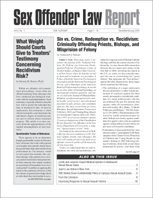International Perspectives on Sex Offender Monitoring
Author: Roslyn Myers, J.D. managing editor of SLR.
Source: Volume 12, Number 06, October/November 2011 , pp.87-88(2)

< previous article |next article > |return to table of contents
Abstract:
Around the world, it is generally agreed that the intended purpose of sex offender registration requirements is to both speed investigations and serve as a deterrent to future crime. Registries are meant: to contribute towards a lower rate of reoffending in sex offenders, since a person's knowledge that he is registered with the police may dissuade him/her from committing further offences and since, with the help of the register, the police may be enabled to trace suspected reoffenders faster. ( Adamson v. the United Kingdom, Application No. 42293/98, Jan. 26, 1999.) The information that is contained in the registries is based on assessments of the offender’s risk to society, and should serve to help law enforcement manage that risk. Notification requirements, which are part of the registry mechanism, allow officers to keep tabs on the activities and general movements of sex offenders, but more importantly, it alerts them if an offender does not notify. There are still debates about the effectiveness of registries.Keywords:
Affiliations:
.